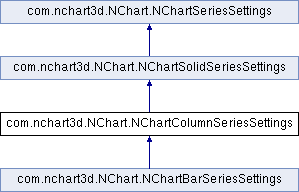NChartColumnSeriesSettings class provides global settings for com.nchart3d.NChart.NChartColumnSeries. More...

Public Member Functions | |
| int | getCylindersResolution () |
| Resolution is the amount of vertices that build the circle. More... | |
| void | setCylindersResolution (int cylindersResolution) |
| For details see getCylindersResolution(). | |
| boolean | shouldSmoothCylinders () |
| Flag that determines if cylinders should appear smooth (true) of faced (false). More... | |
| void | setShouldSmoothCylinders (boolean shouldSmoothCylinders) |
| For details see shouldSmoothCylinders(). | |
| boolean | shouldGroupColumns () |
| Flag that determines if columns should be grouped in the coordinate system cells (true), or not (false). More... | |
| void | setShouldGroupColumns (boolean shouldGroupColumns) |
| For details see shouldGroupColumns(). | |
| float | getColumnGroupFillRatio () |
| Column group fill ratio for series that determines the amount of place for one column group. More... | |
| void | setColumnGroupFillRatio (float columnGroupFillRatio) |
| For details see getColumnGroupFillRatio(). | |
| NChartColumnAnimationType | getAnimationType () |
| Animation type of the transition. More... | |
| void | setAnimationType (NChartColumnAnimationType animationType) |
| For details see getAnimationType(). | |
| float | getCornerRadius () |
| Corner radius of the columns relative to the actual column width. More... | |
| void | setCornerRadius (float cornerRadius) |
| For details see getCornerRadius(). | |
| float | getThickness () |
| Custom thickness of columns in chart coordinates. More... | |
| void | setThickness (float thickness) |
| For details see getThickness(). | |
| NChartValueAxisKind | getThicknessResolvingValueAxis () |
Axis kind the thickness is calculated by. More... | |
| void | setThicknessResolvingValueAxis (NChartValueAxisKind thicknessResolvingValueAxis) |
| For details see getThicknessResolvingValueAxis(). | |
 Public Member Functions inherited from com.nchart3d.NChart.NChartSolidSeriesSettings Public Member Functions inherited from com.nchart3d.NChart.NChartSolidSeriesSettings | |
| float | getFillRatio () |
| Fill ratio for series that determines the amount of place for one series. More... | |
| void | setFillRatio (float fillRatio) |
| For details see getFillRatio(). | |
 Public Member Functions inherited from com.nchart3d.NChart.NChartSeriesSettings Public Member Functions inherited from com.nchart3d.NChart.NChartSeriesSettings | |
| NChartSeriesSettings () | |
| Create instance of settings. | |
| boolean | isRudimentEnabled () |
| Flag determining if rudiment is allowed. More... | |
| void | setRudimentEnabled (boolean isRudimentEnabled) |
| For details see isRudimentEnabled(). | |
Detailed Description
NChartColumnSeriesSettings class provides global settings for com.nchart3d.NChart.NChartColumnSeries.
Member Function Documentation
|
inline |
Animation type of the transition.
The default value is NChartColumnAnimationType.Simultaneously.
|
inline |
Column group fill ratio for series that determines the amount of place for one column group.
For example, if this fill ratio is 1.0, columns in the group are sticked together with no gaps between them. If the fill ratio is 0.5, columns in the group have gaps and the total width of the gaps is equal to the total width all columns in the group.
The default value is 1.0.
The difference from fillRatio is that fillRatio deals with the gap between column groups and columnGroupFillRatio is responsible for the gap between columns inside the group.
- See also
- shouldGroupColumns()
- getFillRatio()
|
inline |
Corner radius of the columns relative to the actual column width.
The default value is 0. If the radius is 0, columns have sharp corners. If the radius is 1, columns have rounded corners with the radius equal to the half of the columns' width.
|
inline |
Resolution is the amount of vertices that build the circle.
For example if you want to get a square column, you should set resolution to 4. If you want to get a cylindrical column, you may set a larger value. But the larger is the resolution, the more memory is used and the slower the rendering will be, so you should find out the minimal acceptable value. A good value for cylinder is 16 or 20.
The default value is 4.
This value cannot be less than 3 and greater than 32.
|
inline |
Custom thickness of columns in chart coordinates.
The default value is 0, which means the thickness is calculated automatically based on the grid resolution and fillRatio (or columnGroupFillRatio if applicable). However if the thickness is set to positive number other than 0, it overrides the automatic calculation. The units are derived from the value axis of the kind set by thicknessResolvingValueAxis. For example, if thicknessResolvingValueAxis = NChartValueAxisX, thickness = 0.5 and the X-axis' min = 0, max = 1, the actual width of columns will be half the X-Axis length.
|
inline |
Axis kind the thickness is calculated by.
The default value is NChartValueAxisX. See thickness property for details. This property has no effect when thickness = 0.
|
inline |
Flag that determines if columns should be grouped in the coordinate system cells (true), or not (false).
The default value is true.
If you have a lot of points that share the same cells, it is good idea to set this flag to true (to let the default), so the columns sharing the cell are distributed in it. However if you have more than one series which points are not sharing the same cells (for example, each series has only one point that monopolizes the cell), it is better to set this flag to false, so the points are not distributed and each one takes its whole cell.
|
inline |
Flag that determines if cylinders should appear smooth (true) of faced (false).
Generally if you specify low resolution (see setCylindersResolution(int) for details) when the individual faces are still visible, it is a good idea to have cylinders faced and vice versa.
The default value is false.
If cylinders are faced, it consumes more memory than if they don't by the same resolution.


